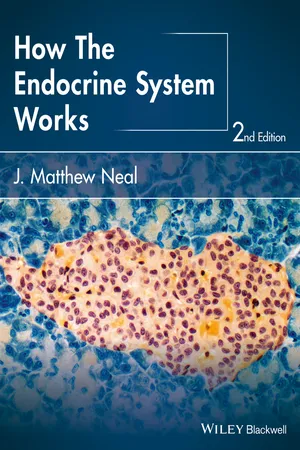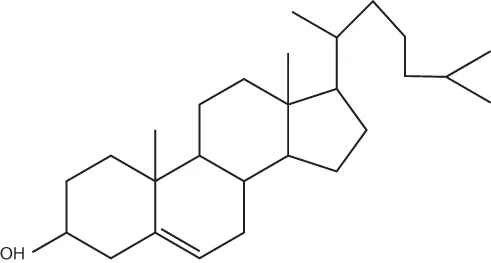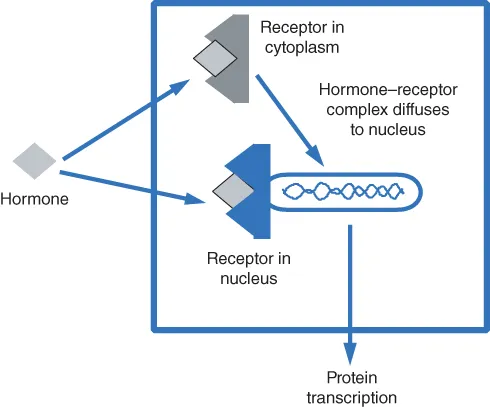
- English
- ePUB (mobile friendly)
- Available on iOS & Android
eBook - ePub
How the Endocrine System Works
About this book
How The Endocrine System Works is not another standard introduction to endocrinology, but an innovative and fun way to learn about the importance of the key glands in the human body and the hormones they control. It is explained in 9 easy-to-understand lectures, with additional material on the treatment and management of endocrine disorders.
How The Endocrine System Works:
- Is designed for those in need of a concise introduction to this fascinating area of medicine
- Has been rigorously updated to reflect today's endocrinology teaching
- Includes more focus on the treatment and management of endocrine disorders
- Features more on evidence-based medicine, obesity, epidemiology, and biostatistics
- Includes summaries of key research that affects diagnostic criteria
- Includes brand new case-based review questions at the end of each chapter
- Features full-color diagrams throughout
How The Endocrine System Works is the perfect introduction for all medical students, as well as for students of bioscience, and other healthcare disciplines.
Frequently asked questions
Yes, you can cancel anytime from the Subscription tab in your account settings on the Perlego website. Your subscription will stay active until the end of your current billing period. Learn how to cancel your subscription.
At the moment all of our mobile-responsive ePub books are available to download via the app. Most of our PDFs are also available to download and we're working on making the final remaining ones downloadable now. Learn more here.
Perlego offers two plans: Essential and Complete
- Essential is ideal for learners and professionals who enjoy exploring a wide range of subjects. Access the Essential Library with 800,000+ trusted titles and best-sellers across business, personal growth, and the humanities. Includes unlimited reading time and Standard Read Aloud voice.
- Complete: Perfect for advanced learners and researchers needing full, unrestricted access. Unlock 1.4M+ books across hundreds of subjects, including academic and specialized titles. The Complete Plan also includes advanced features like Premium Read Aloud and Research Assistant.
We are an online textbook subscription service, where you can get access to an entire online library for less than the price of a single book per month. With over 1 million books across 1000+ topics, we’ve got you covered! Learn more here.
Look out for the read-aloud symbol on your next book to see if you can listen to it. The read-aloud tool reads text aloud for you, highlighting the text as it is being read. You can pause it, speed it up and slow it down. Learn more here.
Yes! You can use the Perlego app on both iOS or Android devices to read anytime, anywhere — even offline. Perfect for commutes or when you’re on the go.
Please note we cannot support devices running on iOS 13 and Android 7 or earlier. Learn more about using the app.
Please note we cannot support devices running on iOS 13 and Android 7 or earlier. Learn more about using the app.
Yes, you can access How the Endocrine System Works by J. Matthew Neal in PDF and/or ePUB format, as well as other popular books in Medicine & Endocrinology & Metabolism. We have over one million books available in our catalogue for you to explore.
Information
Lecture 1
An Overview
Endocrinology is the study of endocrine glands and their secretions. It can be a difficult topic to master because of all the mechanisms and feedback loops to understand. Yet, one way to understand the endocrine system is to break it down into smaller parts, and that is what I have attempted to accomplish in this book. It may help to visualize each endocrine system as part of a much larger group; envision a football team with all the players (quarterback, running backs, center, guards, receivers, punter, etc.). Each of these players must perform his job properly for the team to win. If even one player is out of sync, the play may be botched, even if the other players perform flawlessly. (In endocrinology, this happens frequently, as it does in other human disorders.) The quarterback is in charge of the team, calls the plays, and provides leadership. Hopefully your endocrine system has a good quarterback, but, as in football, some turn in lackluster performances, as do some supporting players.
Football teams often communicate plays with audible signals. Complex organisms also require detailed communication for proper function; they have developed hormones to send messages or commands from one part of the organism to another. Simple, one-celled organisms did not have a great need for detailed endocrine systems. But as organisms became more complex, large intercellular communication mechanisms became necessary for homeostasis.
The word “hormone” is derived from the Greek word meaning “arouse to activity.” To many lay people, the word “hormone” conjures up images of estrogen or thyroid replacement therapy. In fact, there are many types of hormones, with new ones discovered every day; some have greater significance than others.
The endocrine system sends signals to the body by secreting hormones (e.g., insulin, growth hormone, thyroxine) directly into the circulation. In contrast, the exocrine glands secrete their substances into a duct system (e.g., sweat glands, exocrine pancreas).
The endocrine system is composed of many different glands throughout the body. The endocrine glands may be divided into two categories. The first, or “classical” glands' functions are primarily endocrine in nature. The second, or “nonclassical” glands' primary functions are something else, but they also secrete important substances.
The “classical” endocrine glands include the anterior pituitary, thyroid, parathyroids, adrenal cortex and medulla, gonads (testes and ovaries), and the endocrine pancreas. The primary function of these glands is to manufacture specific hormones. Some nonclassical endocrine organs and their hormones include the heart (atrial natriuretic peptide), kidney (calcitriol, renin), lymphocytes (cytokines, interleukins), GI tract (gastrin, secretin, vasoactive intestinal peptide), and many others. Many of the “classical” hormones are under the control of the hypothalamus and pituitary, which may be thought of as extensions of the nervous system. Indeed, the nervous and endocrine systems may function together quite closely (neuroendocrinology).
FUNCTION OF HORMONES
So why are hormones so important, anyway? The first thing that an organism must have in order to survive is energy. Food must be converted into energy, excess energy needs to be converted to storage, and stored energy must be mobilized when necessary to meet the organism's needs. In the chapter on glucose metabolism, we will learn the effects of insulin and glucagon on the body's metabolism and the many disorders where things go awry. Thyroid hormones are important in the regulation of the body's metabolism. Glycogen and lipids are necessary to provide long-term energy needs when food is not available.
The organism must maintain its internal environment. This is not as easy as it sounds. Many hormones play a role here. Hormones such as antidiuretic hormone, aldosterone, and atrial natriuretic peptide are important in water and sodium balance. Calcium is necessary for many bodily functions, and its metabolism is regulated by parathyroid hormone and vitamin D. Several hormones, including thyroid hormones, growth hormone, and sex steroids, control growth and development. These all need to work together as a team for the body to exist in an orderly environment.
And, of course, reproduction is essential for the continued survival of any organism. Specialized reproductive organs (gonads) produce sex steroids that are necessary for spermatogenesis and ovulation (as well as normal growth and development). Gonads are under the complex control of the hypothalamic–pituitary axis (HPA).
COMPOSITION OF HORMONES
Hormones are made from a variety of different molecules. The vast majority of hormones are of the protein or peptide variety. Proteins are chains of amino acids linked together. Some of these peptide hormones are only a few amino acids in length; most are much larger, with some being over 200 amino acids in length. Even the very small protein vasopressin (a nonapeptide) looks quite complex.

Arginine Vasopressin
Glycoproteins are sort of a hybrid hormone, consisting of a peptide hormone associated with a carbohydrate moiety. The four human glycoprotein hormones include LH (luteinizing hormone), FSH (follicle-stimulating hormone), TSH (thyroid-stimulating hormone or thyrotropin), and human chorionic gonadotropin (β-hCG). These hormones all share a common alpha subunit (α-SU); the β subunits differ from one to another.
Instead of being linked together to form proteins, one or two amino acids may be modified to form hormones. The amino acid tyrosine is modified to form the catecholamines (e.g., epinephrine and norepinephrine). While technically two amino acids joined together form a peptide, these amino acids are usually modified in some manner. The catecholamine hormones are very important in the nervous system. The thyroid or iodothyronine hormones (thyroxine, triiodothyronine) are made by joining two modified tyrosine molecules and adding several iodine atoms.

Tyrosine
Cholesterol, a molecule that we associate with atherosclerosis, is in fact essential to life. It is the precursor of steroid hormones—such as cortisol, aldosterone, estradiol, and testosterone—and sterol hormones, such as calcitriol.

Cholesterol
Another common hormone precursor is the lowly fatty acid (the major storage component of fat), which serves as a precursor of hormones called eicosanoids. The most important eicosanoids, the prostaglandins, are derived from arachidonic acid. Other eicosanoids include thromboxanes, leukotrienes, and prostacyclins. They are important in smooth muscle contraction, hemostasis, inflammatory and immunologic responses, circulation, and respiratory and gastrointestinal systems.
Simple ions such as calcium also have hormone-like effects, and calcium metabolism will be discussed in Lecture 6.
HOW HORMONES WORK
Hormones must have a way to tell the other cells what to do. The end effect of a hormone is usually at the nucleus, resulting in the production of a protein that has some effect on the cell. Some hormones go directly to the nucleus and have an effect there. These types of hormones tend to be ones that can easily traverse the cell membrane; for this to happen, the hormone usually must be “nonpolar” (non-charged). These include the steroid and iodothyronine hormones.

Hormones Interacting Directly with Nuclear or Cytoplasmic Receptors
The second class of hormones have no direct effect but instead bind to cell surface receptors, which initiates production of one or more second messengers that carry out the action. One messenger may trigger another messenger, which may trigger yet another, and so on. This concept of “multiple messengers” is called an amplification cascade and is the reason that some of these hormones are effective at extremely low concentrations (e.g., 10−12 mol/L). An analogy to the game of football would be a running back carrying the ball behind his blockers. Without the blockers, he is likely to be tackled quite quickly, ending the play abruptly; with multiple blockers, his power is “amplified” to the extent that many more yards can be gained than would have been possible alone. These hormones tend to be highly electrically charged, and include polypeptide, glycoprotein, and catecholamine hormones, and therefore cannot easily traverse the cell membrane....
Table of contents
- Cover
- Title Page
- Copyright
- Table of Contents
- Acknowledgments
- How to Use this Book
- Lecture 1: An Overview
- Lecture 2: Pituitary and Hypothalamus
- Lecture 3: The Thyroid
- Lecture 4: Adrenal Gland
- Lecture 5: Glucose Metabolism
- Lecture 6: Calcium Metabolism
- Lecture 7: Reproductive Endocrinology
- Lecture 8: Lipid Disorders
- Lecture 9: Disorders of Multiple Endocrine Glands and Paraneoplastic Syndromes
- Appendix: Clinical Trials, Evidence-Based Medicine, and Reading the Literature
- Glossary
- Index
- End User License Agreement